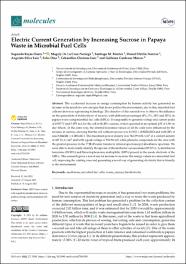Electric Current Generation by Increasing Sucrose in Papaya Waste in Microbial Fuel Cells

Ver/
Descargar
(application/pdf: 2.188Mb)
(application/pdf: 2.188Mb)
Fecha
2022-08-15Autor(es)
Rojas-Flores, Segundo
De La Cruz-Noriega, Magaly
Benites, Santiago M.
Delfín-Narciso, Daniel
Angelats-Silva, Luis
Díaz , Felix
Cabanillas-Chirinos, Luis
Gallozzo Cardenas, Moises
Metadatos
Mostrar el registro completo del ítemResumen
“The accelerated increase in energy consumption by human activity has generated an
increase in the search for new energies that do not pollute the environment, due to this, microbial fuel
cells are shown as a promising technology. The objective of this research was to observe the influence
on the generation of bioelectricity of sucrose, with different percentages (0%, 5%, 10% and 20%), in
papaya waste using microbial fuel cells (MFCs). It was possible to generate voltage and current peaks
of 0.955 V and 5.079 mA for the cell with 20% sucrose, which operated at an optimal pH of 4.98 on
day fifteen. In the same way, the internal resistance values of all the cells were influenced by the
increase in sucrose, showing that the cell without sucrose was 0.1952 ± 0.00214 KΩ and with 20% it
was 0.044306 ± 0.0014 KΩ. The maximum power density was 583.09 mW/cm2 at a current density
of 407.13 A/cm2 and with a peak voltage of 910.94 mV, while phenolic compounds are the ones with
the greatest presence in the FTIR (Fourier transform infrared spectroscopy) absorbance spectrum. We
were able to molecularly identify the species Achromobacter xylosoxidans (99.32%), Acinetobacter
bereziniae (99.93%) and Stenotrophomonas maltophilia (100%) present in the anode electrode of the
MFCs. This research gives a novel use for sucrose to increase the energy values in a microbial fuel
cell, improving the existing ones and generating a novel way of generating electricity that is friendly
to the environment.“
Colecciones
- Web of Science (WOS) [236]

